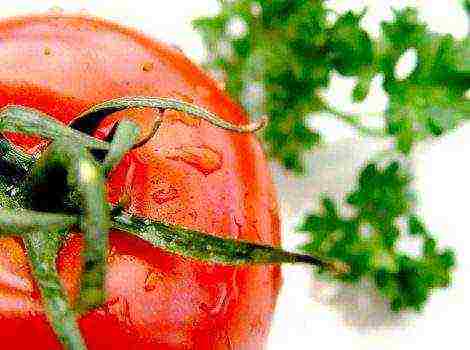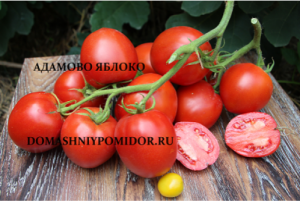Content
- 1 Summer resident
- 2 Drogana yellow
- 3 Mlievskaya yellow
- 4 Backyard yellow
- 5 Chermashnaya
- 6 Yellow types of cherries: description and characteristics
- 7 Yellow cherry varieties
- 8 We plant yellow cherries according to all the rules
- 9 How to care for yellow cherries
- 10 Reviews of gardeners growing yellow cherries
Do you want to grow on your site not only tasty and juicy cherries, but also with attractive berries of an unusual color? Give preference to varieties of yellow cherry!
Their main advantage over classic varieties of sweet cherries with red fruits is the excellent taste of yellow berries and high yield. To make it easier for you to choose the best variety, in this article we will give a detailed description of the most popular and appreciated varieties of yellow cherries by gardeners.
Summer resident
The trees of this variety are medium-sized, with a spreading crown of medium density. They are drought and frost resistant.
The berries of this variety are round-heart-shaped, very juicy, tender, have a good presentation, and they have a good separation of the bone from the pulp. However, this variety is self-fertile, therefore it needs a "neighborhood" with pollinating varieties.
| Entering fruiting | Tree height (m) | Fruit weight (g) | Harvest | Pollinating varieties |
| 4 year | 3,5 | 7-11 | Mid june |
Drogana yellow Melitopol, Mascot |
Drogana yellow
The trees of this variety, popular all over the world, adapt well to various weather conditions, so today this cherry can be found in summer cottages both in Europe and Asia.
The tree grows very tall and leafy, so it takes up quite a lot of space in the garden. But thanks to this, the variety is characterized by a high yield. Flowering occurs relatively late, therefore, return spring frosts, which often occur in the middle lane, are not terrible for cherries.
Please note: this variety of yellow cherries is self-fertile, so you need to plant trees of other varieties nearby.
The Drogan yellow variety is distinguished by rather large rounded berries with a very smooth skin, dense, sweet and juicy light yellow pulp. In this case, the juice has a transparent color. 100 g of light yellow pulp contains 6.6 mg of vitamin C.
In addition to an excellent harvest (up to 150 kg per tree), this cherry is appreciated for its good drought and frost resistance. Plus, she is rarely affected by fungal diseases. The disadvantages include poor separation of the bone from the pulp, as well as poor transportability of the berries due to the very thin peel. And also the berries of Drogana yellow are completely unsuitable for freezing: after defrosting, the berries lose their presentation - their peel bursts, and the pulp spreads.
| Entering fruiting | Tree height (m) | Fruit weight (g) | Harvest | Pollinating varieties |
| 3-5 years later | 5-6 | 6,5-8 |
End of June - early July |
Donchanka, Sister, Aelita |
Mlievskaya yellow
The tree of this variety is above average growth and has a wide pyramidal crown and medium density. Over time, the crown can become rounded and slightly asymmetrical.
The berries of Mlievskaya yellow are rather large, with a glossy golden skin, juicy, semi-hardy and sweet-sour yellow pulp, from which the stone is easily separated. The juice is transparent.
This variety has one significant drawback: in snowless and harsh winters, trees can freeze slightly. Therefore, in the middle lane, they need shelter.But in the southern regions, this variety gives a good harvest without any hassle.
| Entering fruiting | Tree height (m) | Fruit weight (g) | Harvest | Pollinating varieties |
| 4-5 years later | 4 | 4,9-6 |
Second half june |
Self-fertile variety - does not require pollinators |
Backyard yellow
This variety is especially popular in the Central region of Russia, but grows well in other areas as well. At the same time, the tree grows rapidly. It is noteworthy that this variety is early. But usually in central Russia during flowering, the buds do not freeze under spring frosts.
The fruits of this variety are round, with a wide funnel. They have a smooth skin and a very juicy yellow flesh with a sweet and sour taste. 100 g of berries contain 10.6 mg of vitamin C.
The disadvantage of the fruits of the Home Garden yellow cherry is that they contain a rather large stone (8.5% in relation to the weight of the berry). But on the other hand, it separates well from the pulp.
Also, the disadvantages of this variety can be attributed to the hassle of growing: the trees need regular pruning and take up a lot of space in the garden, so it will not be possible to plant many such plants.
| Entering fruiting | Tree height (m) | Fruit weight (g) | Harvest | Pollinating varieties |
| 6 years after planting | 3,5-4 | 5,5 |
First half june |
The variety is self-fertile, not needy in pollinators |
Chermashnaya
The tree is a self-fruitless early variety. Its crown is round or oval, of medium density. Leaves are medium-sized, oval, green. The fruits are distinguished by a very juicy, tender and sweet pulp with a barely perceptible acidity. The berries have a stone (medium size), which is easily separated from the pulp.
The trees of this variety are quite resistant to frost, so they feel good in central Russia, in Belarus and in the north of Ukraine. Plus, they rarely get sick with moniliosis and coccomycosis and, as a rule, are not damaged by pests.
But keep in mind that the winter hardiness of the buds of trees is average, therefore, in the spring, with recurrent frosts, they can freeze slightly.
| Entering fruiting | Tree height (m) | Fruit weight (g) | Harvest | Pollinating varieties |
| For 4-5 years | Up to 5 | 4,5 |
The beginning of June |
Iput, Ovstuzhenka, Raditsa, Fatezh |
We talked about the most popular varieties of yellow cherries. And which one to choose is up to you. Regardless of which variety you prefer, in any case you will be satisfied, because a generous and very tasty harvest of juicy yellow berries will not keep you waiting.
Usually cherry berries are colored red or dark burgundy, but breeders have bred varieties with yellow fruits. These varieties are quite productive, adapt well to different climatic conditions, providing gardeners with a bright, juicy harvest.
Yellow types of cherries: description and characteristics
Yellow cherry differs from its relative with red fruits not only in color, but also in excellent sour-sweet taste and higher yield. But the most important advantage is that yellow fruits are much less likely to lead to an allergic reaction. Bunches of sunny berries against the background of bright green foliage look very attractive, which makes cherries a wonderful decoration for the garden.
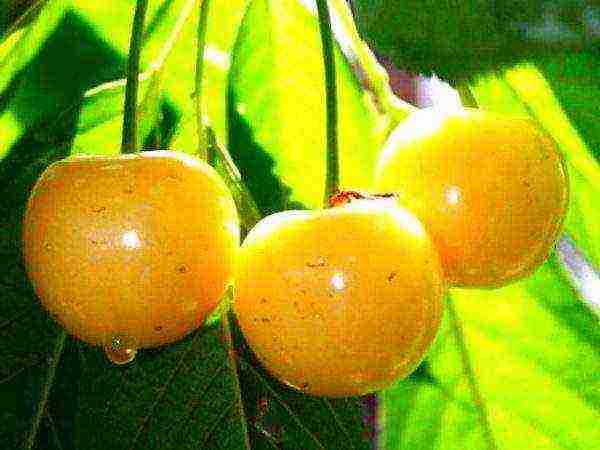
Bunches of yellow berries against the background of foliage look very attractive
The tree can reach a large size - 5–7 m. The crown of yellow-fruited cherry varieties is usually spherical. The skeletal branches are strong and rough.
Due to its significant size, it is recommended to restrain growth through proper pruning and plant formation.
The leaf blades of yellow cherry are slightly elongated, rather large and pointed. The fruits have yellow skin of various shades and light flesh. The berry taste is sweet with a pleasant sourness. The bone is easily separated from the pulp.
Among the varieties of yellow cherry are:
- early (Household yellow);
- late (Drogana yellow, Bryansk, Aelita, Leningrad yellow);
- sweet (Household yellow, Amber);
- winter-hardy (Dachnitsa, Leningradskaya yellow).
Table: the main advantages and disadvantages of sweet cherries with yellow fruits
Video: home garden yellow cherry
Yellow cherry varieties
Breeders have developed varieties of sweet cherries with yellow berries of different shades - from light cream to golden amber. Some of them have blush.
Leningrad yellow
The berries of the Leningradskaya yellow cherry variety are painted in a magnificent amber hue, making tall trees with a spherical crown look very decorative during the fruiting period. The variety is late, the fruits ripen at the end of summer, but after ripening they do not lose their presentation. The trees have excellent winter hardiness and fruit rot resistance. The undoubted advantage of the Leningrad yellow is also the fact that cherries are not damaged by a fruit fly.
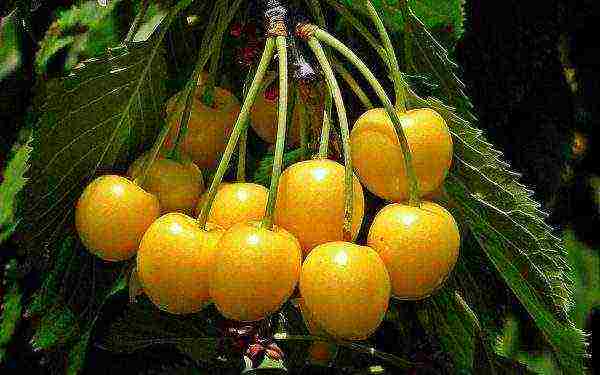
Cherry berries of the Leningradskaya Yellow variety are painted in a magnificent amber shade
Golden fruits have excellent taste with juicy and tart pulp and light sourness. The variety requires pollinators, which can be cherries:
- Dawn;
- Leningrad black;
- Leningrad pink.
Summer resident
Large cherry berries of the Dachnitsa variety ripen in mid-June. Their average weight is 6–8 g. The shape is rounded-heart-shaped. The very thin skin has a beautiful yellowish tint, while the flesh has a creamy tone and colorless juice.

Large cherry berries of the Dachnitsa variety ripen in mid-June
Backyard yellow
The color of the skin of the sweet cherry variety Priusadebnaya is yellow - amber with a light red blush. The rather dense pulp has a pleasant sour-sweet taste. The backyard yellow does not require pollinators, which is an undoubted advantage of this variety.
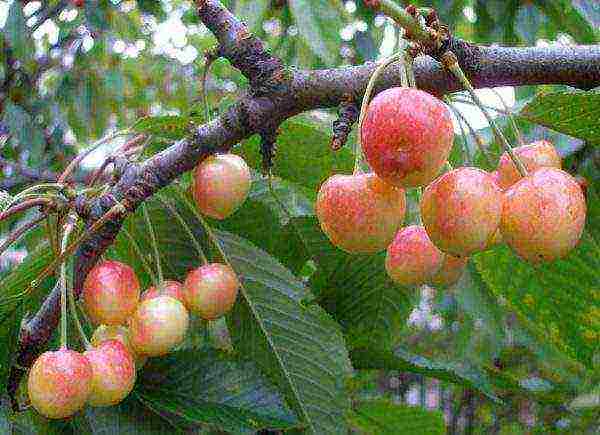
Home garden yellow cherries do not require pollinators
Drogana yellow
This variety of yellow cherry, which is one of the most common in garden plots, has other names - Late yellow, Bigarro Drogana. The fruits are cream colored without blush. Although the flesh is firm, the transportability of the fruit is low due to the thin skin. The size of the berries is above average, the mass of individual fruits reaches 8 g. Among the advantages of Drogana yellow, one can single out a high and stable yield, and the most serious disadvantage is its susceptibility to damage by gray fruit rot. Also, the variety is often attacked by the cherry fly.
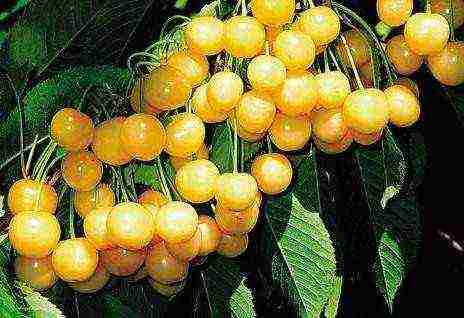
During the fruiting period, the branches of the sweet cherry variety Drogana yellow are strewn with golden fruits
Drogan yellow for good fruiting requires pollinators, which can be varieties:
- Bagration;
- Early Cassini;
- Napoleon pink;
- Denissena yellow;
- Gaucher,
- cherry Griot Ostheim.
Amber
The name of the sweet cherry speaks for itself. The fruits of Amber are colored in a beautiful golden yellow hue. The pulp is dense with an excellent sweet taste and slight sourness.
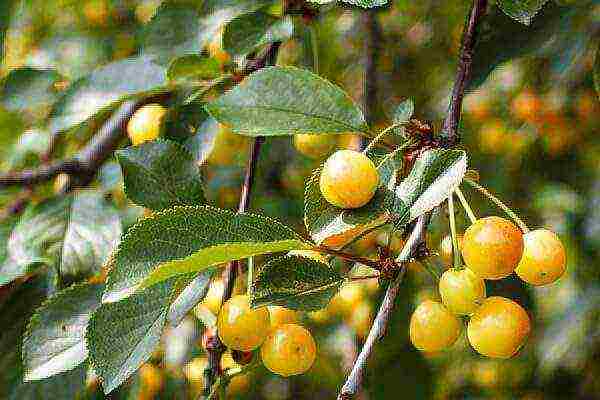
The fruits of Amber are colored in a beautiful golden-yellow hue.
The variety is self-fertile. Next to the Yantarnaya seedling, it is necessary to plant other trees that will pollinate the plant. This role can be assigned to such varieties as:
- Ovstuzhenka;
- North;
- Iput.
Franz Joseph
In the literature, the variety can be found under other names, it is also called Francis and Bigarro Franz Joseph. The tree of this cherry variety has good winter hardiness. The pulp is pinkish-yellow, sweet and tender. The fruit has a beautiful amber hue and is covered with a reddish blush. The following varieties are suitable as pollinators for Franz Joseph:
- Zhabule;
- Drogana yellow;
- South embankment red.
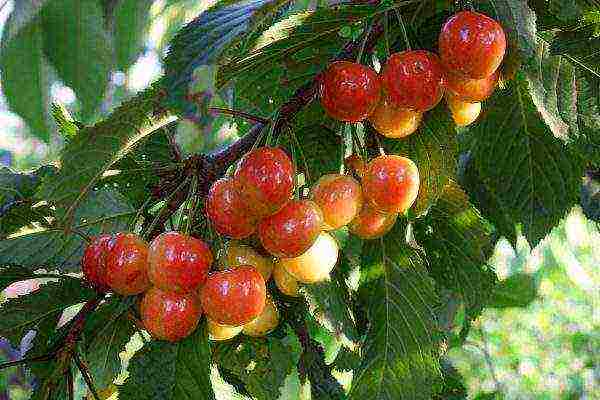
A feature of the Franz Joseph variety is a beautiful blush on yellow berries
Bigarro yellow (Denissena yellow)
The tree of this cherry variety has a wide crown and drooping branches. The berries ripen late and have a very delicate pulp and thin skin, so they often wrinkle.Because of this feature, they should be handled with great care and not transported over long distances. The undoubted advantage of the variety is the excellent taste and aroma of the pulp.
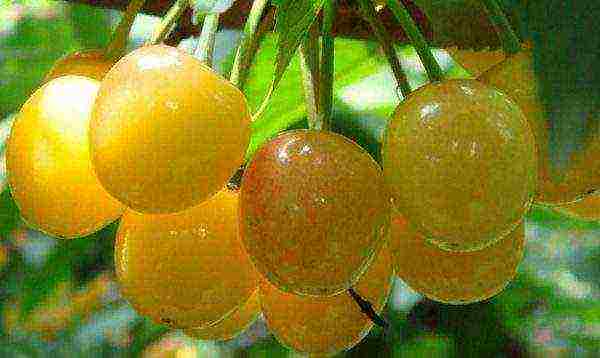
The undoubted advantage of the variety is the excellent taste of the fruit.
To get a good harvest, the plant needs pollinating varieties:
- Gedelfingen;
- South embankment;
- Early Cassini;
- Drogana is yellow.
General's
The cherry fruits of this variety have a yellow skin, covered with a carmine blush. The pulp is dense and tasty - painted in a creamy shade. The berries are of little use for long distance transportation, but they are very tasty and aromatic.
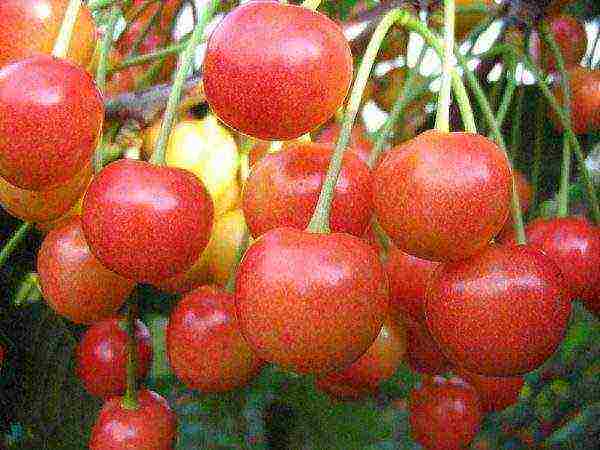
Generalskaya berries are of little use for long-distance transportation, but they are very tasty and fragrant.
Generalskoy requires pollinators, so next to this variety of cherries, you can plant varieties:
- Ovstuzhenka;
- Iput;
- Tyutchevka.
Appetizing
The berries of the yellow-fruited sweet cherry are medium-sized and heart-shaped. The whitish thin skin is covered with a light red iridescent blush, making the fruit look elegant. The delicate pink pulp has an excellent dessert taste with a slight sourness. The variety is capable of producing high yields annually and is immune to coccomycosis.
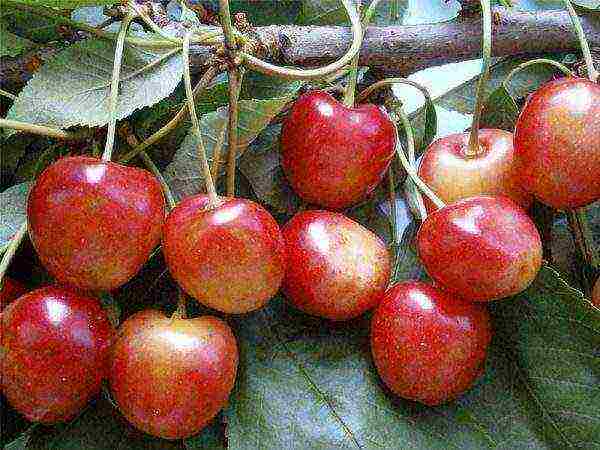
Sweet cherry berries look very elegant
Aelita
The color of cherry fruits of the Aelita variety is yellow-pink, round shape, weight is 9–10 g. The pulp is colored in a light yellow tone and has a sweet taste with a pleasant cherry aroma.
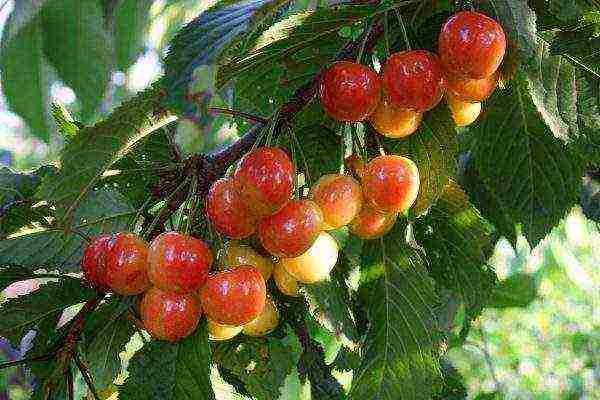
The color of the cherry fruit of the Aelita variety is yellow-pink, the skin is thin, and the flesh is very juicy
The tree is medium-sized, so the crown does not need intensive pruning. Aelite requires pollinators, which are varieties:
- Valery Chkalov;
- Ethics;
- Early pinkness;
- Annushka;
- Drogana yellow;
- Sister.
We plant yellow cherries according to all the rules
For yellow cherries, it is very important to choose the best place for planting. The culture requires excellent lighting and does not tolerate cold and strong winds. Therefore, it is worth picking up a plot on the south side of the garden. Cherry soil prefers loamy and moderately moist.
The culture does not tolerate high groundwater levels.
For planting, choose 1–2 year old seedlings with a developed root system and 3–4 branches. The bark should be smooth, free from any damage or build-up.
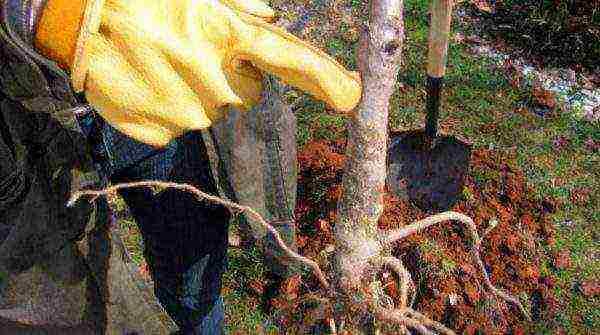
The bark of a cherry seedling should be smooth, without damage and growth
It is advised to arrange seedlings of yellow cherries at least 3 m from each other. For planting, holes are dug about 60–70 cm deep. The top layer of soil is poured onto the bottom, mixed with two buckets of rotted manure, 100 g of potassium sulfate and 400 g of superphosphate. Then cover this layer with ordinary soil to avoid contact between the roots and fertilizers.
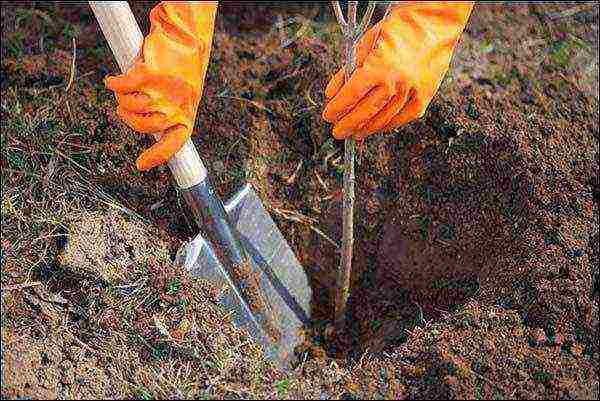
The cherry seedling is covered with soil and compacted, making sure that the root collar of the tree rises 5 cm above the ground
Before planting a seedling in the ground, its roots are soaked in water for 12 hours, and then the root system is dipped in a mash made of clay, mullein and water. A peg is placed in the hole, a seedling is placed, covered with earth and compacted, making sure that the root collar of the tree rises 5 cm above the soil surface. The plant is tied to a support and watered.
How to care for yellow cherries
The main agrotechnical techniques for growing crops are weeding and loosening the near-trunk circle, watering and fertilizing.
Moisturizing and feeding
Yellow cherries prefer regular watering, which should be carried out throughout the growing season. Usually it is enough to pour 2 buckets of water under a tree once a month, but in the absence of rainfall for a long time, it is recommended to increase the amount of irrigation up to 1 time per week.
The first 2-3 years of a young cherry's life do not require additional feeding, since the fertilizers that were placed in the planting pit during planting are enough for it.
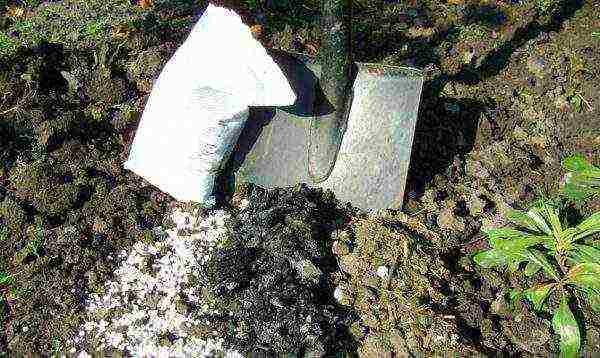
Adult cherries need both organic and mineral supplements
As the tree grows, it is recommended to carry out 3 dressings per season.
- The first is held in April. To do this, small grooves with a depth of about 25 cm are dug along the perimeter of the crown. Urea is poured into them (200 g under one tree), covered with soil and watered abundantly.
- The second top dressing is in late July or early August. During this period, potassium sulfate (100 g) and superphosphate (300 g) are poured into the grooves dug along the perimeter of the crown.
- In the fall, before digging the trunk circle, it is recommended to pour 2 buckets of humus under each cherry tree. Then it is mixed with the ground and the nutrient substrate is watered abundantly.
Pruning and shaping the crown of a tree
Many varieties of yellow cherries are large in size, so it is advised to restrain their growth by pruning. Experienced gardeners recommend pruning the tree in the spring, giving the crown the desired shape. Shoots are shortened by about a third. This technique stimulates the laying of new fruit buds.
Reviews of gardeners growing yellow cherries
Yellow cherries are a real find for a summer resident. Unlike the classic red berries that birds love to feast on, yellow fruits do not attract birds. In addition, these varieties have excellent yields and are able to decorate the site, since the bright amber berries look very decorative.
I am fond of many things. Handicraft, gardening, floriculture and cooking are just a few of my hobbies. I am constantly discovering something new and learning something interesting. I am ready to share all my knowledge with my readers.
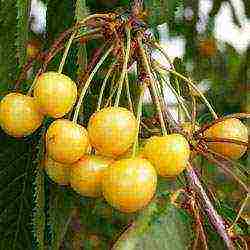 There are a lot of sweet cherry varieties, but not all of them will feel confident and produce crops in cool areas. Here, the cultivation of these fruits directly depends on the resistance of the trees to frost. For example, with yellow berries, cherries are not as picky as their red-fruited relative. Almost all of its varieties grow and bear fruit normally in medium, with cold winters, stripes. Such cherries can be grown without any problems in the Moscow region, as evidenced by photographs and descriptions of some varieties.
There are a lot of sweet cherry varieties, but not all of them will feel confident and produce crops in cool areas. Here, the cultivation of these fruits directly depends on the resistance of the trees to frost. For example, with yellow berries, cherries are not as picky as their red-fruited relative. Almost all of its varieties grow and bear fruit normally in medium, with cold winters, stripes. Such cherries can be grown without any problems in the Moscow region, as evidenced by photographs and descriptions of some varieties.
Classification of cherries
The main areas where cherries are cultivated are southern. But stubborn breeders are constantly promoting this sweet berry north and have already achieved some success. Over the past twenty years, they have developed several dozen varieties that have proven themselves well in cool climates.
Now there are about 4000 known varieties of sweet cherries. All of them are classified according to crown type, ripening time, fruit color, etc.
For example, by the type of pulp, cherry fruits are divided into 2 groups:
- bigarro - the fruits of this group of cherries are endowed with dense pulp with a pleasant crunch and weakly colored or completely colorless juice. Such berries are sweet, dense, well transported. They are used both fresh and in the form of canned food. Ripen either in the middle or late.
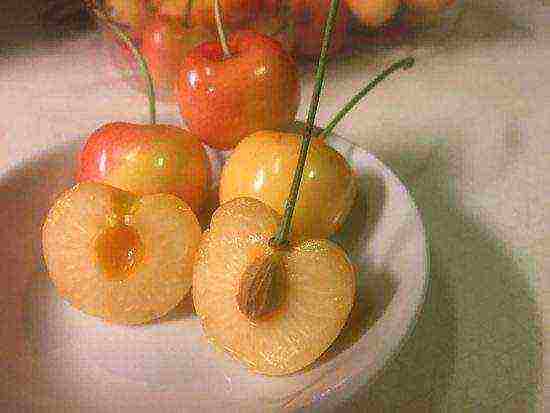
Cherry pulp
- gini - the berries of this group have a very tender, soft pulp. Fruits ripen early and eat them fresh. Not suitable for transportation.
By the formation of the ovary, cherries are divided into:
- self-fertile - capable of forming an ovary with the help of pollination with pollen of their own flowers. On such cherries, fruits are formed from almost half of the opened buds without the participation of insects;
- self-infertile - cherries, the main part of the ovary in which is formed only thanks to the pollen of neighboring trees, that is, cross-pollination with the help of insects. Not far from such varieties, it is required to plant certain varieties of pollinating cherries that bloom at the same time.
By the timing of ripening of fruits, cherries are divided into:
- early maturing - the crop can be harvested in early June;
- mid-ripening - ripening terms mid-end of June;
- late ripening - the berries are ready to eat in mid-July.
Yellow-fruited cherry in the Moscow region
Fruits on cherries can be colored red, yellow, pink and orange.
There are many frost-resistant varieties, but I would like to highlight the yellow-fruited ones separately. There are advantages to growing yellow berries. For example, they are rarely pecked by birds, and during the period of prolonged rains, they practically do not crack.
Backyard yellow. A fairly young variety, but has already become widespread in estates near Moscow.
- Cherry bigarro.
- Self-fertile variety. Gives high yields. The berries ripen in early July.
- Fruits begin to set at the age of 6.
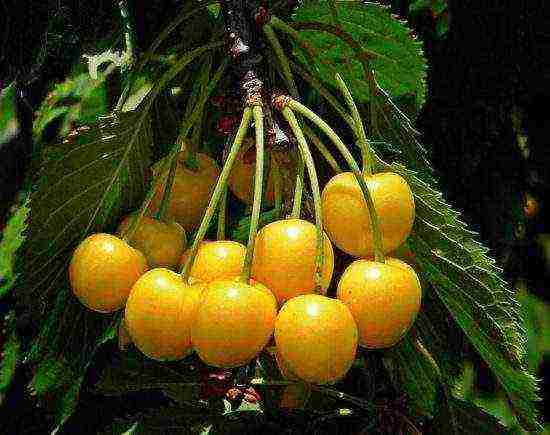
Backyard yellow
- It tolerates the rather cold winter of the middle zone.
- Prefers black soil.
- Not damaged by cherry flies and fungi.
- Needs periodic pruning, as it has a very branched crown.
- The fruits are large, sweet in taste.
Advice. From the berries of this variety, you can make excellent blanks for the winter - they perfectly retain their shape after heat treatment.
Orlovskaya amber:
- Cherries from the bigarro group.
- Needs neighbors-pollinators, which are suitable varieties Revna, Tyutchevka.
- Fruits begin to bear on the 4th year.
- It tolerates cold winters well.
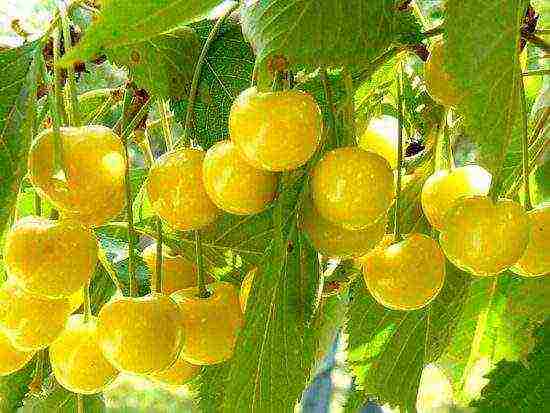
Orlovskaya amber
- Fungi are affected only during prolonged rains with a cold snap.
- Berry picking time is mid-July.
- Fruits are medium in size and sweet.
Drogana yellow:
- Cherry bigarro.
- It tolerates winter very well.
- Itself is not pollinated. Nearby, it is advisable to plant pollinating cherries for Denissen yellow, Gaucher.
- The first harvest takes 4 years.
- The berries are light yellow, sweet, dense. The bone is not separated well.
- The fruits ripen in mid-July.
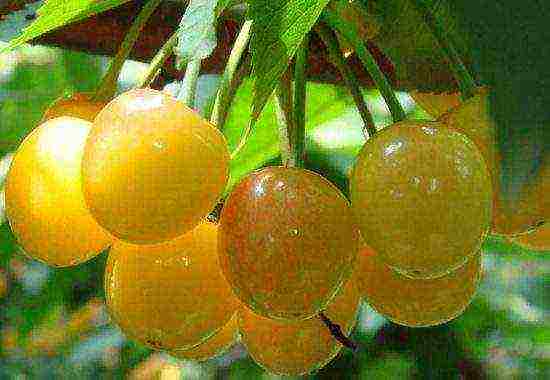
Drogana yellow
Denissen yellow:
- Cherry bigarro.
- Frost resistant.
- High, with a slightly drooping, dense crown.
- It is recommended to plant Drogan yellow as a pollinator nearby.
- Berries are light amber in color with a very delicate pulp.
- Ripening time - mid-July.
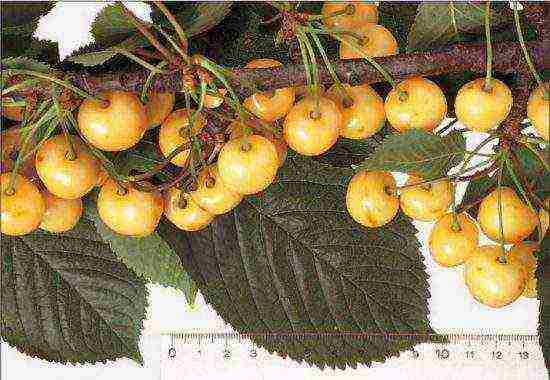
Denissen yellow
Leningrad yellow - one of the old, popular varieties.
- The variety is endowed with a very high winter hardiness.
- The tree is tall with a dense, wide crown.
- It needs pollinators, so it is advisable to plant Leningrad pink or Leningrad black next to it.
- The color of the berries is golden amber. The taste is sweet, slightly tart.
- Harvested in mid-July.

Leningrad yellow
Some rules for growing yellow cherries in the Moscow region
Yellow cherry prefers sunny, windless places. For planting a seedling in the fall, they dig a hole 70 cm deep and 80 cm wide. They fill it with humus and add earth for the winter.
Attention! It is recommended to plant cherry seedlings in a permanent place in the middle lane only in spring. This will allow them to root well and survive the winter normally.
In the spring, a complex mineral fertilizer and wood ash are poured into the hole. You cannot add too much fertilizer, as this provokes the growth of extra branches. A small hill is poured in the center of the hole, a seedling is placed on top and sprinkled with earth. After planting, the plant is watered and mulched. This technique will retain moisture in the soil and prevent weeds from germinating.
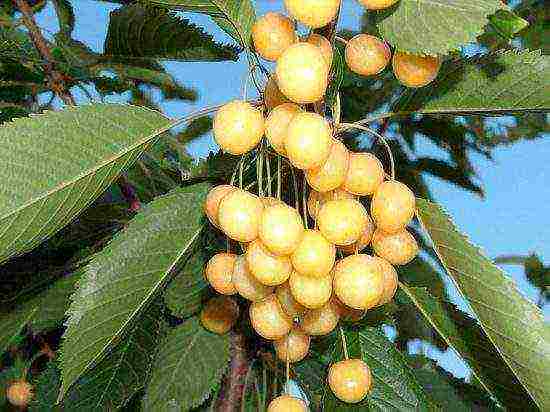
Cherries need proper pruning and shaping
The distance from one cherry to another is required at least 5 m, otherwise, with age, the trees will begin to shade each other. Pruning should be done in the spring. In summer and autumn, only dried or broken branches can be removed. The place of the cut must be cleaned and processed with garden putty.
Cherries are watered very rarely, during a long period of absence of rain. As a prophylaxis of fungal diseases, the tree is treated with appropriate preparations according to the instructions. In the spring and autumn, it is advisable to whitewash the trunk.
No matter how difficult it may seem to grow cherries in the conditions of the Moscow region and the entire middle zone, it is worth it. After all, a berry harvested from its site will definitely be tastier than a purchased one brought from distant, warm lands.
Denisen's yellow cherry variety: video
